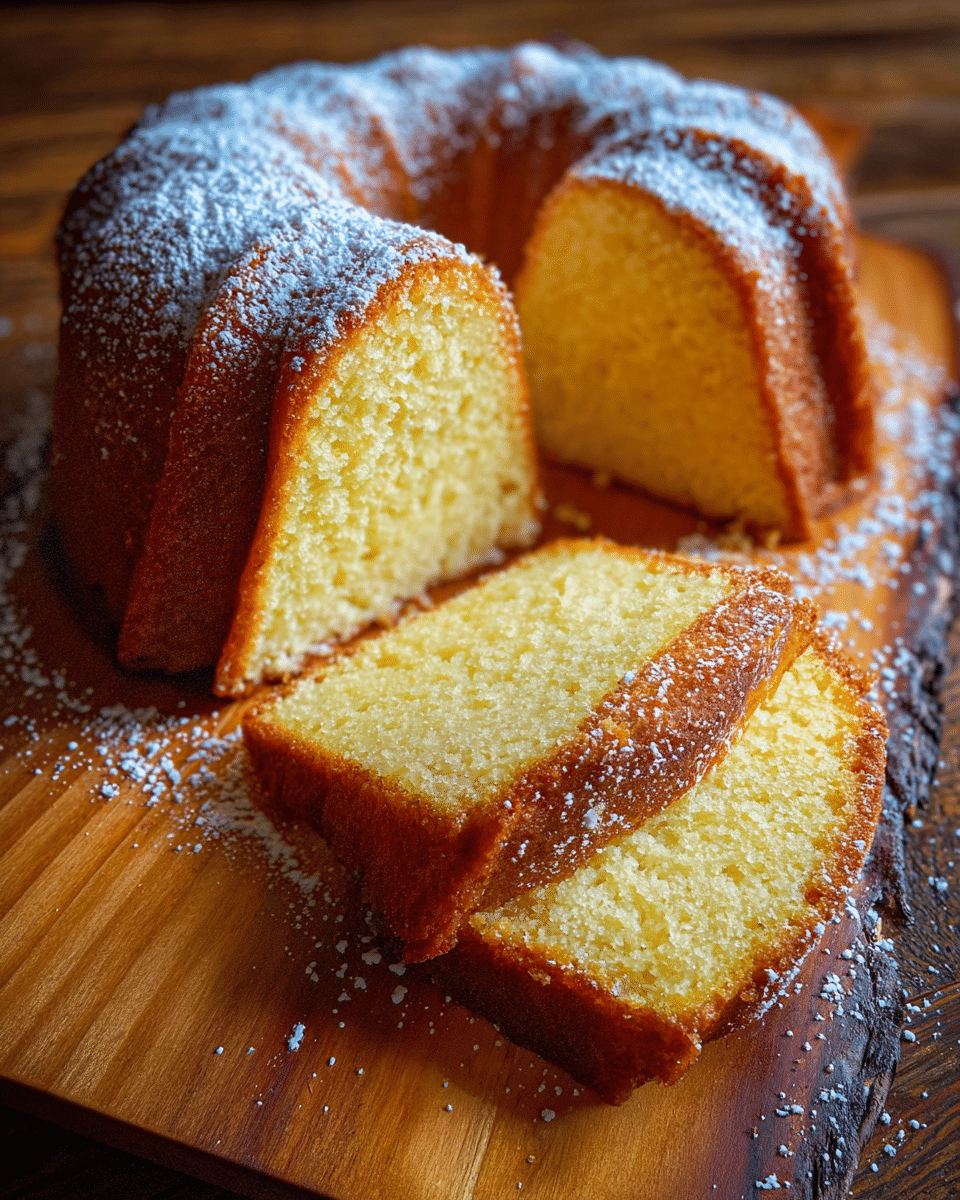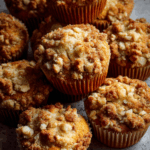The Traditional Buttermilk Pound Cake is a classic Southern dessert that brings nostalgia and warmth to any table. Known for its dense, buttery crumb and subtle tang from buttermilk, this cake is perfect for afternoon tea or as a sweet finish to a family meal. With simple ingredients and a straightforward method, it’s a timeless recipe cherished for its rich flavor and moist texture.
FULL RECIPE
Ingredients
- 3 cups all-purpose flour
- 1 teaspoon baking powder
- ½ teaspoon salt
- 1 cup unsalted butter, softened
- 2 cups granulated sugar
- 4 large eggs
- 1 cup buttermilk
- 2 teaspoons vanilla extract
- Powdered sugar, for dusting (optional)
Directions
- Preheat the oven to 325°F (163°C). Grease and flour a 10-inch bundt or tube pan.
- In a medium bowl, whisk together the flour, baking powder, and salt. Set aside.
- In a large mixing bowl, beat the softened butter and sugar together until light and fluffy, about 4-5 minutes.
- Add the eggs one at a time, beating well after each addition. Stir in the vanilla extract.
- Alternately add the flour mixture and buttermilk to the butter mixture, beginning and ending with the flour mixture. Mix until just combined.
- Pour the batter evenly into the prepared pan and smooth the top with a spatula.
- Bake for 70-80 minutes or until a toothpick inserted in the center comes out clean.
- Allow the cake to cool in the pan for about 15 minutes, then invert onto a wire rack to cool completely.
- Once cooled, dust with powdered sugar if desired before serving.
Nutrition Facts
- Calories: 450 per serving (1/12th of cake)
- Protein: 5g
- Carbohydrates: 65g
- Dietary Fiber: 1g
- Sugars: 40g
- Fat: 18g
- Saturated Fat: 11g
- Cholesterol: 110mg
- Sodium: 220mg
History and Origins of Pound Cake
The pound cake traces its roots back to 18th-century Europe, where it was originally named for its simple recipe: a pound each of flour, butter, sugar, and eggs. This traditional cake became a staple in Southern American kitchens, evolving to incorporate buttermilk for added moisture and a subtle tang. Its dense texture and rich flavor made it a favored dessert during holidays and family gatherings, embodying comfort and hospitality. Over time, the buttermilk pound cake has become synonymous with Southern charm and classic baking traditions.
Role of Buttermilk in Pound Cake
Buttermilk plays a crucial role in the texture and flavor of this pound cake. Its acidity reacts with baking powder to create a tender crumb and slight rise in what is otherwise a dense cake. The buttermilk also imparts a mild tanginess that balances the richness of the butter and sugar. Additionally, its liquid content contributes moisture, ensuring the cake remains soft and moist even days after baking. This ingredient elevates the pound cake beyond a simple butter cake into a delicately flavored dessert.
Key Ingredients and Their Functions
The foundation of this pound cake lies in a handful of classic ingredients, each with a distinct purpose. Butter provides richness, flavor, and tenderness, while sugar contributes sweetness and helps create a light, airy texture when creamed with butter. Eggs act as a binder and add moisture, as well as contribute to the structure and leavening. Flour provides the framework, and baking powder ensures the cake rises. Vanilla extract adds subtle aromatic depth. Together, these ingredients harmonize to produce the signature dense yet tender crumb of a traditional pound cake.
Techniques for Achieving Perfect Texture
Achieving the perfect texture in a buttermilk pound cake requires careful mixing and baking. Creaming the butter and sugar well incorporates air, which helps lighten the dense batter. Adding eggs one at a time ensures they emulsify properly, creating a smooth batter. Alternating dry ingredients with buttermilk prevents overmixing, which can lead to a tough cake. Baking at a moderate temperature for a longer time allows the cake to cook evenly without drying out. Letting the cake cool in the pan briefly before removing helps it hold its shape and prevents cracking.
Variations to Customize Flavor and Texture
This classic recipe lends itself well to variations. Adding citrus zest, such as lemon or orange, introduces a fresh brightness that contrasts beautifully with the buttery richness. Swirling in fresh berries or chopped nuts adds texture and bursts of flavor. For a more decadent twist, some bakers incorporate cream cheese into the batter or glaze the cooled cake with a simple powdered sugar icing. Substituting part of the flour with almond flour can yield a nuttier taste and slightly different crumb texture, making the recipe versatile for different preferences.
Ideal Pairings and Serving Suggestions
Buttermilk pound cake is wonderfully versatile in how it can be served. It pairs beautifully with fresh fruit such as berries or peaches, which add natural sweetness and juiciness. A dollop of whipped cream or a scoop of vanilla ice cream enhances its indulgence, making it perfect for celebrations or dessert. For a simpler approach, a light dusting of powdered sugar highlights its rustic charm. This cake is also ideal for tea time or brunch, served alongside coffee or a glass of cold milk, offering a comforting and satisfying treat.
Storage and Shelf Life Tips
Proper storage is essential to maintain the moistness and freshness of the pound cake. Wrapped tightly in plastic wrap or stored in an airtight container, the cake can stay fresh at room temperature for up to three days. For longer storage, refrigeration is recommended but may slightly dry the cake; reheating slices briefly in a microwave can restore softness. Pound cake freezes well when wrapped securely, lasting up to three months in the freezer. Thaw frozen cake overnight in the refrigerator or at room temperature before serving.
Nutritional Considerations
Traditional buttermilk pound cake is rich and calorie-dense, reflecting its high butter and sugar content. It provides a good amount of energy and fat, with moderate protein from eggs. While delicious as an occasional treat, it is best enjoyed in moderation as part of a balanced diet. For those seeking lighter alternatives, reducing sugar or substituting some butter with oil can lower calories and fat. However, these changes may affect the texture and flavor that define the classic pound cake experience.
Common Baking Challenges and Solutions
Baking a pound cake comes with a few common challenges, including dryness, cracking, or sinking in the middle. Dryness often results from overbaking, so it’s important to check the cake with a toothpick near the end of the baking time. Cracking on top can occur if the oven is too hot or if the batter is overmixed; baking at a moderate temperature and gentle mixing helps prevent this. A sunken center usually indicates underbaking or too much leavening agent. Using fresh baking powder and avoiding opening the oven door too early will yield the best results.
Advertisement
Cultural Significance and Popularity
The traditional buttermilk pound cake holds a special place in Southern cuisine and culture. It is a symbol of home, family, and shared moments, often passed down through generations as a cherished recipe. Its simplicity and richness reflect the resourcefulness and warmth of Southern cooking traditions. Today, this cake continues to be celebrated in bakeries and homes across the country, representing comfort food at its finest and serving as a nostalgic reminder of Southern hospitality.
Conclusion
The Traditional Buttermilk Pound Cake is much more than a simple dessert — it is a beloved Southern classic steeped in history and flavor. Its dense yet tender crumb, enhanced by the tang of buttermilk and richness of butter, makes it a timeless treat suitable for many occasions. Whether enjoyed plain or with creative variations, this pound cake delivers comfort and indulgence with every slice. By understanding its ingredients, techniques, and cultural roots, home bakers can appreciate the art behind this humble yet iconic dessert.






